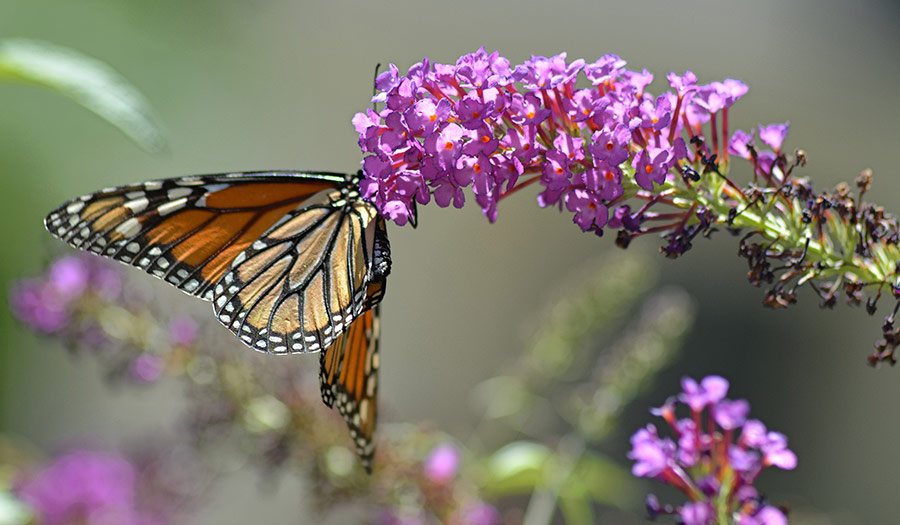 Getty Images
Getty Images
World News Desk
Learn the why behind the headlines.
Subscribe to the Real Truth for FREE news and analysis.
Subscribe NowA 37-year survey of monarch populations in North Central Florida shows that caterpillars and butterflies have been declining since 1985 and have dropped by 80 percent since 2005.
This decrease parallels monarchs’ dwindling numbers in their overwintering grounds in Mexico, said study co-author Jaret Daniels, associate curator and program director of the Florida Museum of Natural History’s McGuire Center for Lepidoptera and Biodiversity.
“It’s alarming in a number of different ways,” said Dr. Daniels, who is also an associate professor in the University of Florida’s department of entomology and nematology. “This study shows the tight connection between monarchs and milkweed and highlights very dramatic losses in abundance in Florida that further confirm the monarch is declining.”
While the drivers of the decline are not clear, the researchers said shrinking native milkweed populations and a boost in glyphosate use in the Midwest are part of the problem.
Glyphosate, an herbicide often applied to agricultural fields to eliminate weeds, is lethal to milkweed, the monarchs’ host plant. Less milkweed means less habitat for monarchs, said study co-author Ernest Williams, professor emeritus of biology at Hamilton College in New York.
“A broad pattern is that 95 percent of corn and soybean products grown in the U.S. are Roundup Ready crops that resist glyphosate,” Dr. Williams said. “That has a national impact. What’s really needed are patches of native vegetation and nectar sources without pesticides. It’s not just for monarchs but all pollinators.”
In the longest location-based monarch monitoring effort to date, a multi-institute team led by world-renowned monarch expert Lincoln Brower—who died earlier this year—closely followed spring monarch numbers in an herbicide-free cattle pasture in Cross Creek, Florida. The team examined milkweed plants for caterpillars and captured adult butterflies for 37 years, a period spanning more than 140 generations of monarchs.
They found that monarchs’ springtime departure from Mexico is timed to coincide with optimal growth of milkweed in the southeastern U.S. While adult monarch butterflies can feed from a variety of plants, their young depend on milkweed as their sole source of nutrition, storing up the plant’s toxins to ward off predators.
Monarchs lay hundreds of eggs on milkweed over their brief lifetimes, but just over 2 percent of eggs survive to become fully grown caterpillars.
If monarchs get to their breeding grounds too early, they run the risk of their host plants being killed by frosts—too late and the plants may not be able to support their young. To maximize their offspring’s chances of survival, the butterflies must time their arrival in the U.S. within a three-week window, Dr. Daniels said, an impressive feat for insects with lifespans between six and eight weeks.
Florida is an important stopover for monarchs returning north from Mexico, as spring breeding in southern states leads to the butterflies’ recolonization of the upper U.S. and Canada. Monarchs rely on Florida for its abundance of milkweed and warm climate to lay the eggs that will help replenish the eastern population in the U.S., Dr. Daniels said.
“Florida is kind of a staging ground for the recolonization of much of the East Coast,” he said. “If these populations are low, then the northern populations are going to be at a similar abundance level.”
But although monarchs are a well-studied species, consistent long-term studies of changes in their spring breeding are rare, Dr. Williams said.
“Long-term studies like this are important because they point to larger trends,” Dr. Williams said. “Before 2005, there was more fluctuation in the data. Since 2005, the rate of decline has been steady.”
Dr. Daniels said that increasing pesticide-free native milkweed populations in Florida yards and on roadsides is a step in the right direction to prevent monarchs from requiring protection under the Endangered Species Act.
But, he emphasized, not any milkweed will do.
Asclepias curassavica, or tropical milkweed, is a commercialized, non-native tropical species that has become popular with growers because of its color and year-round vegetation. But tropical milkweed can become an “ecological trap” for monarchs, coaxing them into breeding in unusual areas during the winter months—areas far enough north of Mexico to remain prone to freeze events throughout the winter and early spring, Dr. Daniels said.
Prolonged breeding can also lead to an increase in a protozoan parasite that infects monarchs.
“It’s not as simple as saying, ‘we plant milkweed and the monarch will be saved,’” Dr. Daniels said. “We should think of this as an ecological issue. There are a lot of complexities to any organism and any system.”
More on Related Topics:
- With Sewage Gushing into Sea, U.S. and Mexican Border Towns Plead for Help
- Mass Fish Death in Mexico’s Chihuahua State Blamed on Severe Drought
- It Is So Hot in Mexico, Howler Monkeys Are Falling Dead from the Trees
- Too Much Water, and Not Enough: Brazil’s Flooded South Struggles to Access Basic Goods
- E-waste Is Overflowing Landfills. At One Sprawling Vietnam Market, Workers Recycle Some of It


